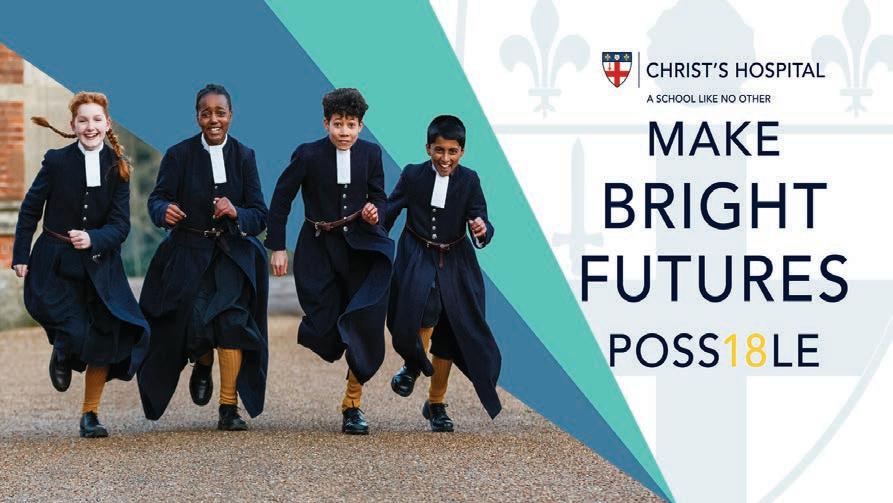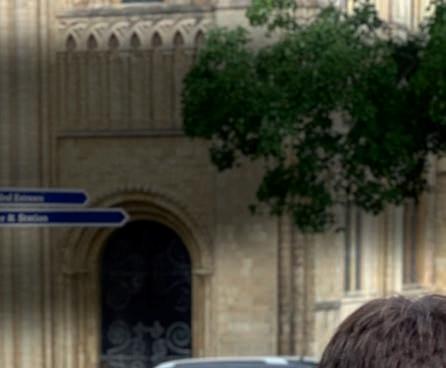
8 minute read
Securing a Bright Future Bursary
Photos by Toby Philips Photography
SECURING BRIGHT FUTURES
Hugo Middlemas describes the successful bursary fundraising campaign run by Christ’s Hospital in a time of unprecedented disruption and considers what school development teams can learn from challenges of the past.
Is your school exploring how its bursary programme can be funded in the face of today’s many fi nancial pressures ave you seen levels of hardship emerge within your school community unknown for many years s it your ambition to start or extend a bursary programme in order to help Do you want to increase your school’s charitable impact and drive social mobility hether you have a evelopment function or rely on volunteer led fundraising, you will have many considerations. hat are the merits of redirecting existing fundraising activity to bursaries ow do you fi t a bursary fundraising message within your existing communications ho will be most li ely to respond
This article shares the experience of managing a new bursary fundraising campaign, launched four months before the pandemic but cognisant of the already worsening conditions for children from socially and economically challenging bac grounds. t the time of writing the campaign is exceeding income and participation expectations.
Challenging times – new opportunities?
While independent schools respond to the huge fi nancial and logistical challenges brought by the pandemic, many have simultaneously needed to support families facing hardship. rom increased outreach activity to hardship appeals and the provision of e uipment for home learning, schools responded swiftly and admirably in the early stages of the crisis. ome have also needed to reassess means tested bursary levels in families’ changing circumstances. t Christ’s ospital, the average means tested bursary has been increased from 83% to 86% – a signifi cant fi nancial impact given the bursaries in place this year. s many schools experienced with their hardship appeals in , challenging times can lead to a rallying of support from parents, alumni and others. Channelling people’s response to a threat to an institution and the children it is there to support, while avoiding panic, is familiar territory for those involved in fundraising. The s ill comes in maintaining the uplift in interest.
There is no doubt that the pandemic has increased awareness and empathy for those most affected – whether families now struggling to get by or those already facing signifi cant vulnerability. This is a time when parents, alumni and other sta eholders may appreciate the value of establishing, maintaining or extending a bursary programme. urther, the experience of home based learning will have awa ened a new level of interest amongst parents and alumni in teaching and learning and an appreciation
of the particular advantages available to those experiencing independent provision. As argued by the Institute of Public Policy Research (IPPR) in the New Normal: The Future of Education after COVID-19 published in October 2020, this is an opportunity to reimagine education with a re-focus on preparing children for life and embracing the power of technology – areas of great strength in the independent sector, with increased access through bursary programmes a powerful tool to address inequalities both inside and outside the classroom.
COVID-19 has not been a great leveller: disproportionately it has affected the lowest paid, those on the frontline and those already facing social disadvantage. The unprecedented disruption to teaching and learning is likely to have widened the already stark attainment gap in the UK, with signifi cant implications for educational and social mobility.
Creating Bright Futures

Christ’s Hospital is somewhat unusual in the scale of its bursary programme and therefore in the profi le of its alumni and parents. With almost all alumni and 75% of current pupils benefi ting from signifi cant means-tested bursaries, there is a passionate commitment to maintaining and growing the bursary programme to help drive UK social mobility. This said, the limited fi nancial means of parents and often modest disposable income of alumni requires high levels of donation participation for the bursary programme to continue. There is also particular reliance on the school’s high value ‘child sponsorship’ philanthropic product, which sees ‘Governors’ making a gift equivalent to the full fees or a proportion of fees and supporting a specifi c pupil during their time at Christ’s Hospital.
It was against this background that, in 2019, Christ’s Hospital considered its response to an emerging trend of falling donation participation – the number of donors dropping by 20% since 2017 – and increasing evidence that social mobility was stagnating in the UK. It was clear that new energy needed to be injected into our communications – and the worsening UK situation provided both context and urgency.
With a number of ongoing fundraising activities in play, from bursary to capital, a unifying, mission-focused, time-limited campaign was seen as the best fi t. The resulting ‘Bright Futures’ campaign had an ambition to raise £1.5m in two years towards bursaries for high-need children, with a principal focus on alumni and current/former parents.
The launch of the Bright Futures campaign in September 2019 used traditional methods, with an appeal mailing to all alumni and parents. What differed from previous appeals was the urgency of the language used and a ramping up of the imagery. The results were rapid, with over £300,000 donated and pledged in response to the launch mailing – more than fi ve times as much as any mailing appeal in the past 20 years or so.
Maintaining the campaign’s momentum for two years through highly engaging communications across multiple platforms was critical, as was having enough opportunities for asking. Giving Tuesday in December 2019 – the world day of giving – provided the next vehicle. All expectations were blown away with £200,000 donated, with half of all donations coming from alumni and parents who had never given before. Christ’s Hospital’s previous record income for Giving Tuesday had been £10,000.
The arrival of the pandemic in early 2020 coincided with advanced planning for the next stage of Bright Futures – Christ’s ospital’s fi rst fully integrated appeal across mail and digital platforms, due to launch in May. The argument for more bursary places was strengthening by the day, but many pupils’ parents were facing increased hardship and alumni spoke of growing fi nancial and employment challenges. Many voices sounded caution – this was surely the wrong time to send an appeal when so many feared for their futures?


Deep breaths were a en a e r responses to the appeal were awaited

Much consultation and further strengthening of the campaign message, acknowledging the extreme challenges that pupils’ families and others like them faced, helped navigate this dilemma. Ultimately launching in June, deep breaths were ta en as the fi rst responses to the appeal were awaited. nce again, the results were astonishing. further £200,000 in donations and pledges and higher engagement with social media and other digital activity than ever before. n the eve of iving Tuesday , the right utures campaign stood at a healthy . m against the . m target. mportantly, the campaign has helped achieve a increase in donation participation compared to the previous year. any lessons have been learned along the way – the importance of being transparent with alumni and parents; focusing on what stakeholders most cherish about your school and articulating a bursary programme’s relevance to the challenges young people in the UK are facing today.
Is now the right time to fundraise for bursary programmes?
ill history repeat itself ac in , the world of evelopment, li e many professions, was reeling from the impact of the global fi nancial crisis of . An 11% fall in the value of donations by individuals in the led to high profi le cuts to charitable activity and concerns about the future. Today, as schools and charities grapple with the lasting impact of the pandemic, will we see a similar fall in donation income? Will launching new fundraising initiatives for bursary programmes be a viable option?
Stories of major charities losing large proportions of their fundraising income have been in the news for some months now. hile the Charities id oundation reported a increase in donations by individuals in the fi rst half of , will the wave of donations to NHS charities and C related initiatives be sustained or will 2021 see a decline in donations as in 2009?
Returning to 2009 and, digging below the surface, one notices that some organisations experienced a sustained increase in donations during the time of the global fi nancial crisis and its long shadow. hat were these organisations doing and what can schools learn from them, particularly in terms of bursary programmes? irst and foremost, those organisations that grew fundraising income in 2009 were investing in the supporter experience. They focused on the needs and interests of their supporters, inspired them to get involved through sharing stories of impact and ma ing engagement easy. espite the temptation to batten down the hatches and cut activity, these organisations continued to communicate openly with their supporters and helped them to feel part of something bigger.
What does this mean for your school in The pandemic has been a catalyst for altruism, with many people searching for ways to create positive change. ut how can this desire to help others be harnessed when so many charities and other organisations are facing crises themselves? believe that with the right engagement, independent schools are perfectly equipped to help their alumni and parents create lasting change at this challenging time. our school will have an extraordinary bond with many of your alumni and parents that can inspire confi dence. They will understand intuitively the benefi ts that a bursary at your school can provide a young person who is facing challenges in their life. erhaps this is the ideal moment to bring together the needs of our society, the peaked altruism of your alumni and parents and the transformative power of education? ●
HUGO MIDDLEMAS is Development Director at Christ’s Hospital and a Trustee of the Windlesham Foundation Trust. He has nearly 25 years’ Development experience across charities, schools and the NHS alongside a background in industry.










